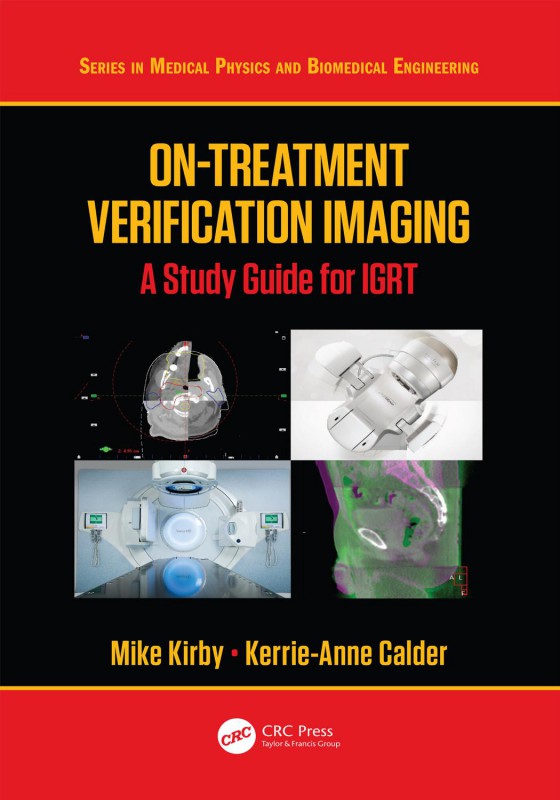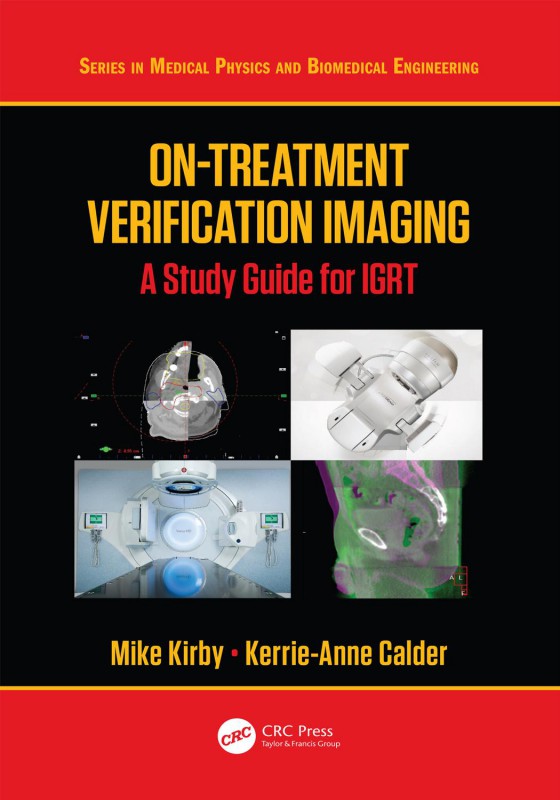(Ebook PDF) On treatment Verification Imaging A Study Guide for IGRT 1st edition by Mike Kirby, Kerrie Anne Calder 1351007742 9781351007740 full chapters
$50.00 Original price was: $50.00.$25.00Current price is: $25.00.
Authors:Mike Kirby; Kerrie-Anne Calder , Series:Biomedical [72] , Author sort:Kirby, Mike & Calder, Kerrie-Anne , Languages:Languages:eng , Published:Published:Apr 2019 , Publisher:CRC Press
On-treatment Verification Imaging: A Study Guide for IGRT 1st edition by Mike Kirby, Kerrie-Anne Calder – Ebook PDF Instant Download/DeliveryISBN: 1351007742, 9781351007740
Full download On-treatment Verification Imaging: A Study Guide for IGRT 1st edition after payment.

Product details:
ISBN-10 : 1351007742
ISBN-13 : 9781351007740
Author : Mike Kirby, Kerrie-Anne Calder
On-treatment verification imaging has developed rapidly in recent years and is now at the heart of image-guided radiation therapy (IGRT) and all aspects of radiotherapy planning and treatment delivery. This is the first book dedicated to just this important topic, which is written in an accessible manner for undergraduate and graduate therapeutic radiography (radiation therapist) students and trainee medical physicists and clinicians. The later sections of the book will also help established medical physicists, therapeutic radiographers, and radiation therapists familiarise themselves with developing and cutting-edge techniques in IGRT. Features: Clinically focused and internationally applicable; covering a wide range of topics related to on-treatment verification imaging for the study of IGRT Accompanied by a library of electronic teaching and assessment resources for further learning and understanding Authored by experts in the field with over 18 years’ experience of pioneering the original forms of on-treatment verification imaging in radiotherapy (electronic portal imaging) in clinical practice, as well as substantial experience of teaching the techniques to trainees
On-treatment Verification Imaging: A Study Guide for IGRT 1st Table of contents:
SECTION I The Basic Foundations in Clinical Practice
CHAPTER 1 ▪ The Concepts and Consequences of Set-up Errors
1.1 INTRODUCTION
1.2 DEFINITION OF “SET-UP ERROR” AND HOW THESE ERRORS ARE CLASSIFIED
1.2.1 Systematic and Random Errors
1.2.2 Gross Errors
1.3 CONSEQUENCES OF EACH TYPE OF ERROR AND THE IMPACT ON TREATMENT DELIVERED
1.4 CORRECTION OF SET-UP ERRORS
CHAPTER 2 ▪ The Foundations of Equipment Used for Radiotherapy Verification
2.1 INTRODUCTION
2.2 IMMOBILISATION EQUIPMENT
2.2.1 Indexing
2.3 INTRODUCTION TO IMAGING SCIENCE
2.4 PRETREATMENT IMAGING
2.4.1 CT
2.4.1.1 Considerations When Using CT
2.4.2 MRI
2.4.3 PET, PET/CT
2.4.4 Simulator
2.4.5 Reference Images
2.5 TREATMENT DELIVERY AND ON-TREATMENT VERIFICATION IMAGING
2.5.1 MV
2.5.2 kV
2.5.3 CBCT
2.5.4 In-room CT
2.5.5 MR Linac
CHAPTER 3 ▪ Concepts of On-treatment Verification
3.1 INTRODUCTION
3.2 HOW TO IMAGE
3.2.1 Reference Images
3.2.2 Types of Reference Images
3.2.2.1 Simulator Image
3.2.2.2 DRR—Digitally Reconstructed Radiograph
3.2.2.3 DCR—Digital Composite Radiograph
3.2.2.4 CT Data Set
3.2.3 Verification Technique
3.2.3.1 MV Imaging
3.2.3.2 kV Imaging
3.2.3.3 Cone Beam CT Scans (CBCT)
3.3 WHEN TO IMAGE
3.4 METHOD OF IMAGE MATCHING
3.4.1 Bony Match
3.4.2 Fiducial Marker Match
3.4.3 Soft Tissue Match
3.5 WHEN TO CHECK THE IMAGE
3.5.1 On-line Review
3.5.2 Off-line Review
3.5.3 Review Method
CHAPTER 4 ▪ Clinical Protocols and Imaging Training
4.1 INTRODUCTION
4.2 IMAGING PROTOCOLS
4.3 TRAINING
4.3.1 Who to Train?
4.3.2 When to Train?
4.3.3 How to Train?
4.3.4 Does Training Need to Be Repeated?
4.3.5 Student Image Training
CHAPTER 5 ▪ Concomitant Exposures and Legal Frameworks
5.1 INTRODUCTION
5.2 CONCOMITANT DOSE–DEFINITIONS
5.3 LEGAL FRAMEWORKS
5.4 INCORPORATION INTO PRACTICAL USE
CHAPTER 6 ▪ Foundational Principles of Protocols, Tolerances, Action Levels and Corrective Strategies
6.1 INTRODUCTION
6.2 TOLERANCES
6.3 MARGINS
6.4 CORRECTIVE STRATEGIES
6.4.1 NAL Correction Strategy
6.4.2 eNAL Correction Strategy
6.4.3 Absolute Correction and Adaptive Radiotherapy (ART)
6.5 ACTION LEVELS
SECTION II Technology and Techniques in Clinical Practice
CHAPTER 7 ▪ Imaging Science, Imaging Equipment (Pretreatment and On-treatment)
7.1 INTRODUCTION
7.2 IMAGING SCIENCE CONCEPTS
7.2.1 Spatial Resolution
7.2.2 Contrast
7.2.3 Noise
7.2.4 Signal-to-Noise (SNR) Ratio
7.3 CHARACTERISTICS OF NOTE FOR X-RAY IMAGING
7.3.1 X-ray Attenuation
7.3.2 Scatter
7.3.3 2-D Projection Images
7.3.4 Subject Contrast and X-ray Energy
7.3.5 Signal-to-Noise Ratio (SNR)
7.3.6 Spatial Resolution
7.3.7 Detective Quantum Efficiency
7.4 PRETREATMENT IMAGING EQUIPMENT
7.4.1 Radioisotope Imaging
7.4.2 Positron Emission Tomography
7.4.3 Computed Tomography—3-D
7.4.4 Computed Tomography—4-D
7.4.5 PET-CT Imaging
7.4.6 Magnetic Resonance (MR) Imaging
7.5 ON-TREATMENT IMAGING ON TRADITIONAL C-ARM LINACS
7.5.1 Why the Need for On-treatment Verification Imaging?
7.5.2 Evolution of On-treatment Imaging
7.5.3 Initial Challenges
7.5.4 The Active Matrix Flat-Panel Imager (AMFPI)
7.5.5 Current Methods With MV and kV X-rays—2-D Imaging
7.5.5.1 Surrogates
7.5.5.2 Surrogates—Skin Markers (Alone) and Bony Anatomy
7.5.5.3 Surrogates—Implanted Fiducial Markers
7.5.5.4 Image Reference Points—Measuring Set-Up Error
7.5.5.5 2-D Planar Imaging—Bony Anatomy
7.5.5.6 2-D Planar Imaging—Fiducials
7.5.5.7 2-D Planar Imaging—Other Technological Points
7.5.6 Current Methods With MV and kV X-Rays—3-D Imaging
7.5.6.1 Evolution of 3-D Imaging Dedicated for C-arm Linacs
7.5.6.2 MV-Based CBCT
7.5.6.3 kV-Based CBCT
7.5.6.4 kV-Based CBCT: Experience, Advantages, and Disadvantages
7.6 ON-TREATMENT IMAGING USING IN-ROOM X-RAY TECHNOLOGY ON C-ARM LINACS
7.6.1 In-room kV Imaging Technologies
7.6.2 CT On Rails
7.6.3 2-D kV Stereoscopic In-room Imaging
7.7 ON-TREATMENT IMAGING USING NONIONISING RADIATION TECHNOLOGY AROUND TRADITIONAL C-ARM LINACS
7.7.1 Rationale
7.7.2 Technologies and Equipment
7.7.2.1 Ultrasound
7.7.2.2 Surface Methods
7.7.2.3 Implanted Transponders
CHAPTER 8 ▪ Clinical Practice Principles
8.1 INTRODUCTION
8.2 PRETREATMENT IMAGING EQUIPMENT
8.2.1 Radioisotope Imaging
8.2.2 PET Imaging and PET/CT
8.2.3 Computed Tomography (CT)—3-D
8.2.4 Computed Tomography (CT)—4-D
8.2.5 MR Imaging
8.3 ON-TREATMENT IMAGING ON TRADITIONAL C-ARM LINACS
8.3.1 2-D MV Imaging
8.3.2 2-D kV Images
8.3.3 Cone-Beam CT (CBCT)
8.4 CASE EXAMPLES
8.5 ON-TREATMENT IMAGING USING IN-ROOM X-RAY TECHNOLOGY AROUND TRADITIONAL C-ARM LINACS
8.5.1 “CT-On-rails”
8.5.2 Stereoscopic In-room Imaging
8.6 ON-TREATMENT IMAGING USING NONIONISING RADIATION TECHNOLOGY AROUND TRADITIONAL C-ARM LINACS
8.6.1 Ultrasound
8.6.2 Case Examples
8.6.2.1 Prostate Verification
8.6.2.2 Breast Localisation
8.6.2.3 Limitations of Ultrasound in Radiotherapy
8.6.3 Surface Tracking
8.6.4 Case Examples
8.6.4.1 SRS
8.6.4.2 Limitations of Surface Tracking
8.6.5 Implanted Transponders
CHAPTER 9 ▪ Quality Systems and Quality Assurance
9.1 INTRODUCTION
9.2 DEFINITIONS—QUALITY MANAGEMENT SYSTEMS (QMSs)
9.3 DEFINITIONS—QUALITY ASSURANCE (QA)
9.4 DEFINITIONS—QA AND QMS PRACTICALITIES FOR ON-TREATMENT VERIFICATION IMAGING
SECTION III Advanced Issues, Techniques, and Practices
CHAPTER 10 ▪ Alternative Technologies
10.1 TOMOTHERAPY
10.1.1 Introduction
10.1.2 System Overview
10.1.3 On-treatment Verification Imaging
10.1.4 Some Clinical Perspectives
10.2 CYBERKNIFE
10.2.1 The Cyberknife System
10.2.2 On-treatment Verification Imaging Systems
10.2.3 On-treatment Imaging Capabilities
10.3 GAMMA KNIFE
10.3.1 The Gamma knife System—Introduction
10.3.2 On-treatment Verification—First Automation
10.3.3 The Gamma Knife Perfexion (GKP) System—Further Automated Verification
10.3.4 On-treatment Imaging—Development of CBCT
10.4 HALCYON
10.4.1 The Halcyon System—Introduction
10.4.2 First Version Imaging Options and Capability
10.4.3 Continuing Developments
10.5 VERO
10.5.1 The Vero 4DRT System—Introduction
10.5.2 Imaging Options and Capability; Initial Results
10.6 PROTON-BEAM THERAPY
10.6.1 Introduction
10.6.2 Technology Changes
10.6.3 Clinical Utility
10.6.4 Clinical Challenges
10.6.5 On-treatment Imaging
10.7 MR On-treatment IMAGING
10.7.1 Introduction
10.7.2 On-treatment MR Guidance
10.7.3 Pretreatment MR and MR-Only Workflows
10.8 PET-MR
10.8.1 Introduction
10.8.2 Initial Investigations and Challenges
10.8.3 Clinical Utility
10.8.4 Imaging Capability
10.9 EMISSION-GUIDED/BIOLOGY-GUIDED RADIOTHERAPY (EGRT/BGRT)
10.9.1 Introduction
10.9.2 Initial Design and Clinical Utility
10.10 ADAPTIVE RADIOTHERAPY
10.10.1 Introduction
10.10.2 Adaptive Radiotherapy Performed Off-line
10.10.3 Adaptive Radiotherapy Performed On-line
10.10.4 Experience With Different On-treatment Imaging Technologies
10.10.5 Adaptive Radiotherapy in Clinical Use
CHAPTER 11 ▪ Incident Reporting
11.1 INTRODUCTION
11.2 RATIONALE
11.3 UK EXPERIENCES
11.4 UK LEGISLATION AND GUIDANCE
11.5 INTERNATIONAL PERSPECTIVES
CHAPTER 12 ▪ Protocol Development and Training
12.1 PROTOCOLS—THE RATIONALE
12.2 DEVELOPING PROTOCOLS FOR ON-TREATMENT VERIFICATION IMAGING
12.3 TRAINING—THE RATIONALE
CHAPTER 13 ▪ Commissioning of New On-treatment Imaging and Techniques: Integration Into the Oncology Management System
13.1 INTRODUCTION
13.2 COMMISSIONING
13.3 INTEGRATION INTO THE ONCOLOGY MANAGEMENT SYSTEM
People also search for On-treatment Verification Imaging: A Study Guide for IGRT 1st:
non-invasive imaging
b-scan in ophthalmology
b scan technique
b-scan retinal detachment
ct ip w validation
You may also like…
eBook PDF
Study Guide for Focus on Nursing Pharmacology 6th Edition by Amy Karch ISBN 1451171161 9781451171167












